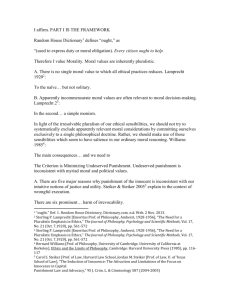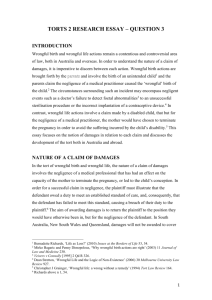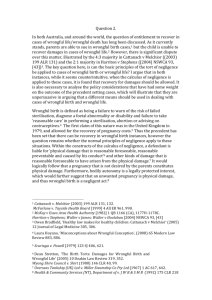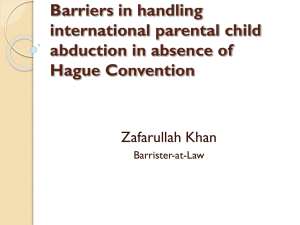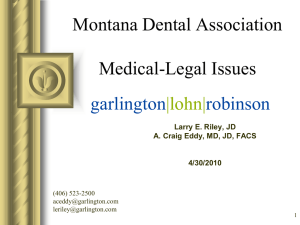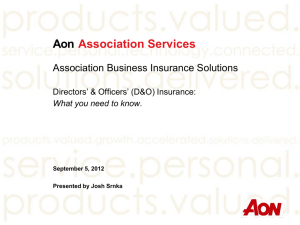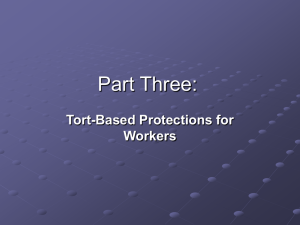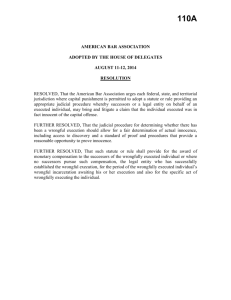or “wrongful birth” lawsuits - Disability Rights Education & Defense
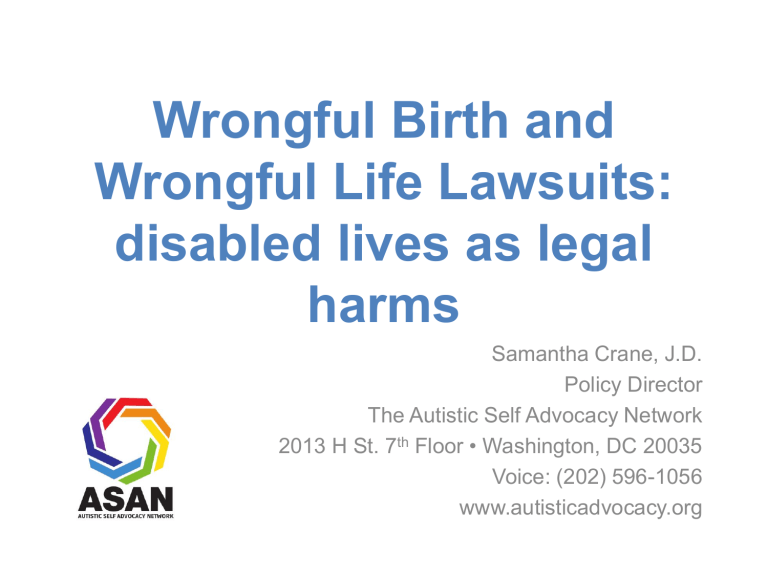
Wrongful Birth and
Wrongful Life Lawsuits: disabled lives as legal harms
Samantha Crane, J.D.
Policy Director
The Autistic Self Advocacy Network
2013 H St. 7 th Floor • Washington, DC 20035
Voice: (202) 596-1056 www.autisticadvocacy.org
Acknowledgments
Wendy F. Hensel, The Disabling Impact of Wrongful
Birth and Wrongful Life Actions, 40 H ARV . C IVIL
R IGHTS -C IVIL L IBERTIES L. R EV . 141 (2005) http://www.law.harvard.edu/students/orgs/crcl/vol40_1/hensel.pdf
Sam Bagenstos, Hedonic Damages, Hedonic
Adaptation, and Disability, 60 Vanderbilt L. Rev.
745, 785 (2007) http://papers.ssrn.com/sol3/papers.cfm?abstract_id=928883
Wrongful Birth and Wrongful Life Actions
“Wrongful birth” and “wrongful life” lawsuits are legal actions claiming that a person with a disability should not have been born.
Example: A pregnant woman undergoes an amniocentesis.
Due to a laboratory error, the fetus tests negative for Down
Syndrome even though the fetus does have Down
Syndrome. The woman sues the laboratory, claiming that she would not have brought the pregnancy to term if she had known the fetus had Down Syndrome.
What aren’t we talking about?
• Claims for medical malpractice that caused harm to the fetus or parent
• Legally prohibiting termination of pregnancy based on disability
• Non-disability-based lawsuits over the denial of the right to terminate a pregnancy
Physical Disability: Bryan Santana
Photograph of
Santana’s mother, Ana
Mejia, as she tearfully testified in court about her son’s disabilities
Florida, 2011: $4.5 million awarded to parents of child born without arms and only one leg.
Mother testified that, if doctor had correctly diagnosed via ultrasound,
“she would have terminated the pregnancy rather than subject
Bryan to what she believes will be a life of physical and psychological pain and untold hardship.” http://www.palmbeachpost.com/news/news/familyseeks-millions-from-obstetrician-ultrasound/nLxZx/
Intellectual Disability: Kalanit Levy
Oregon, 2012: $2.9 million awarded to couple whose child was born with Down
Syndrome. The couple argued that, if the prenatal test had accurately diagnosed the fetus, they would have sought an abortion.
http://www.oregonlive.com/portlan d/index.ssf/2012/03/jury_rules_in_ portland-area_co.html
Photograph of Kalanit alongside her two brothers.
The faces have been pixelated for privacy. The children are smiling and embracing.
Background: Elements of a Medical
Malpractice Lawsuit
1. Duty of care: a medical professional with relationship to patient
2. Breach of duty: may be intentional or through carelessness (“negligence”)
3. Causation: Breach must cause some event
4. Damages: Event must be recognizable as a harm
Example: Ordinary
Medical Context
• Duty: A woman visits her doctor for an annual checkup and undergoes routine lab tests.
• Breach: The doctor fails to notice elevated white blood cell count in the lab report.
• Causation: Thinking everything is ok, the doctor doesn’t order follow-up tests that would have revealed the patient has leukemia.
The woman does not get a leukemia diagnosis or receive treatment until the cancer is very advanced.
• Damages: The woman needs much more expensive cancer treatment than she otherwise would have, suffers loss of income after having to quit her job, and finally dies.
What makes Wrongful
Birth/Wrongful Life Different?
• In wrongful birth and wrongful life lawsuits, the damages arise from the fact that the child was born with a disability.
– Wrongful birth lawsuits (most common) frame these damages as harm to the parent (e.g., the expense of caring for the child and paying for necessary services).
– Wrongful life lawsuits (least common) frame these damages as harm to the child (e.g., the “suffering” the child experiences as a result of being born disabled)
In both cases, damages can include costs to support the person over entire lifetime.
Contrast with:
• Lawsuits for birth injuries or other disabilities/injuries caused by the doctor
– These are seen as “normal” malpractice
• Lawsuits for injury to parent as a result of not terminating risky pregnancy
– Also “normal” malpractice
• Lawsuits over birth of nondisabled child (e.g., failed sterilization/abortion)
– Courts allow these as long as damages are limited to the expense and distress associated with pregnancy – do not award damages for costs of child-rearing
Pause for Questions
Different Protection for Different Choices
• Plaintiffs can only win if they can prove they would have chosen to terminate pregnancy
– Parents who got accurate diagnoses, or who can’t credibly testify that they would have sought an abortion, don’t get compensation
• No “reverse” cause of action
– No known case compensating parents who terminate based on false positive test, or due to misleading information about diagnosis.
• No way for parents of unwanted but nondisabled children to win costs of supporting child
– Only births of disabled children are “harms.”
Coercive Impact of Disparately Available
Remedies
• Families who sue for wrongful birth feel that doing so is necessary in order to provide for disabled child
– Levy family attorney: “This has always been only about providing for their daughter and making her life the best that they can make it.” *
– Santana attorney: “"We're here for an amount to fund
Bryan's life care plan.” *
• This means families must testify that they would have wanted to terminate pregnancy in order to access this source of funding for their child’s needs
Effect on Adaptation to Disability
“By focusing on the negative feelings that occur during
[the initial adjustment] period, plaintiffs with disabilities may delay or derail their ultimate ability to adapt to their new condition.
***
If nothing else, the drive to avoid cognitive dissonance can lead a person who repeatedly testifies (even insincerely) about her lost enjoyment of life to come to believe that testimony.”
– Sam Bagenstos, Hedonic Damages, Hedonic Adaptation,
and Disability, 60 Vanderbilt L. Rev. 745, 785 (2007)
(discussing “quality of life” damages in personal injury cases).
Example: Santana coverage
Now nearly three years old, Bryan is a happy toddler, but Mejia and her husband Rodolfo
Santana know his future is bleak.
vs.
Defense attorney: “He’s dearly loved by his family.
They can't imagine a life without him. They wouldn't give him up for all the money in the
world. So why are we here?” http://www.palmbeachpost.com/news/news/west-palm-beachparents-seek-9-million-to-pay-for-/nLxXW/
Example: Levy coverage
Experts have told the Levys that she likely won't be able to live on her own, or support herself. The Levys worry about who will care for their daughter once they are gone.
http://www.oregonlive.com/portland/index.ssf/2012/0
3/portland_couple_sues_legacy_he.html
Contrast with Lawsuits Concerning
Unwanted Nondisabled Children
“[P]arents of a normal, healthy child cannot establish the fact of damage with reasonable certainty…. [A]llowing recovery would brand the child an ‘emotional bastard.’”
“We simply will not collaborate in conduct that disparages an innocent child.”
– Moorman v. Walker, 773 P.2d 887
(Wash. Ct. App. 1989).
Contrast with Lawsuits Concerning
Unwanted Nondisabled Children
“[A]n unhandsome, colicky or otherwise "undesirable" child would provide fewer offsetting benefits, and would therefore presumably be worth more monetarily in a
"wrongful birth" case. The adoption of that rule would thus engender the unseemly spectacle of parents disparaging the "value" of their children or the degree of their affection for them in open court.”
“[I]t is impossible to tell, at an early stage in the child's life, whether its parents have sustained a net loss or net gain.”
– McKernan v. Aasheim, 102 Wn.2d 411, 687 P.2d 850
(1984).
Class Impact
• Lawsuits only available to parents who actually obtained prenatal screening and would have been able to access abortion
• Like all medical malpractice litigation, wrongful birth lawsuits require ability to pay for medical expert testimony.
– Upper-class couples more likely to be able to pay legal expenses up-front
– Also more likely to find “contingency-based” representation, since attorneys count on class-based juror bias
• Others must rely on social safety net, including
“spending down” assets to access Medicaid, home- and community-based services
Precedential/Persuasive Impact
• Courts usually require that wrongful birth action be based on the claim that a “child has such gross deformities, not medically correctable, that the child will never be able to function as a normal human being.”
– Arche v. U.S. Dep’t of Army, 798 P.2d 477, 480–81 (Kan. 1990)
(describing requirements of a wrongful birth action in Kansas)
• American jurisprudence relies significantly on citing other court’s holdings or reasoning in previous decisions concerning similar or analogous subject matter
• As a result, courts’ recognition of disabled lives as harms in wrongful birth contexts can impact courts’ reasoning in other contexts, including:
– Euthanasia or assisted suicide
– Surrogate decisionmaking re: end-of-life care
Precedential/Persuasive Impact
• One court upholding wrongful birth action hinted at possibility of holding parents liable for failing to failing to abort child with disability:
“If a case arose where, despite due care by the medical profession in transmitting the necessary warnings, parents made a conscious choice to proceed with a pregnancy, with full knowledge that a seriously impaired infant would be born, that conscious choice would provide an intervening act of proximate cause to preclude liability insofar as defendants other than the parents were concerned. Under such circumstances, we see no sound public policy which should protect those parents from being answerable for the pain, suffering and misery which they have wrought upon their offspring.”
Curlender v. Bio-Science Laboratories, 165 Cal. Rptr. 477 (Cal. Ct.
App. 1980).
• California legislature responded by passing law against this sort of lawsuit: Cal. Civ. Code § 43.6 (West 2003)
Pause for Questions
Alternative Options?
• Legislatively abolishing wrongful life or wrongful birth actions
– Must draft carefully to avoid infringement of remedies for personal injury to child or gestational parent, or infringement of overall right to autonomy
– Goal = ensuring that certain choices or lives are not implicitly valued over others
Alternative Options?
• Limiting “wrongful birth” actions to costs of pregnancy/childbirth, like wrongful birth actions concerning nondisabled children
• “No-Fault” compensation system outside of courts
– Suggested by Art Caplan (NYU Bioethicist) http://vitals.nbcnews.com/_news/2012/03/09/10624089-bioethicist-parents-shouldnt-haveto-sue-over-wrongful-birth-of-child-with-down-syndrome?lite
– Still favors parents who could obtain prenatal testing over parents who do not
Alternative Options?
• Comprehensive regulation of genetic testing
– Suggested by Hensel in Disabling Impact of
Wrongful Birth and Life Actions
– FDA is actually in the process of increasing regulation of genetic testing
• Expanding litigation options to include actions against doctors for providing incorrect information about disability prognosis, leading to termination
Questions?
Comments?
Thank You!
ASAN Website: www.autisticadvocacy.org
Samantha Crane, Director of Public Policy,
Autistic Self Advocacy Network: scrane@autisticadvocacy.org
